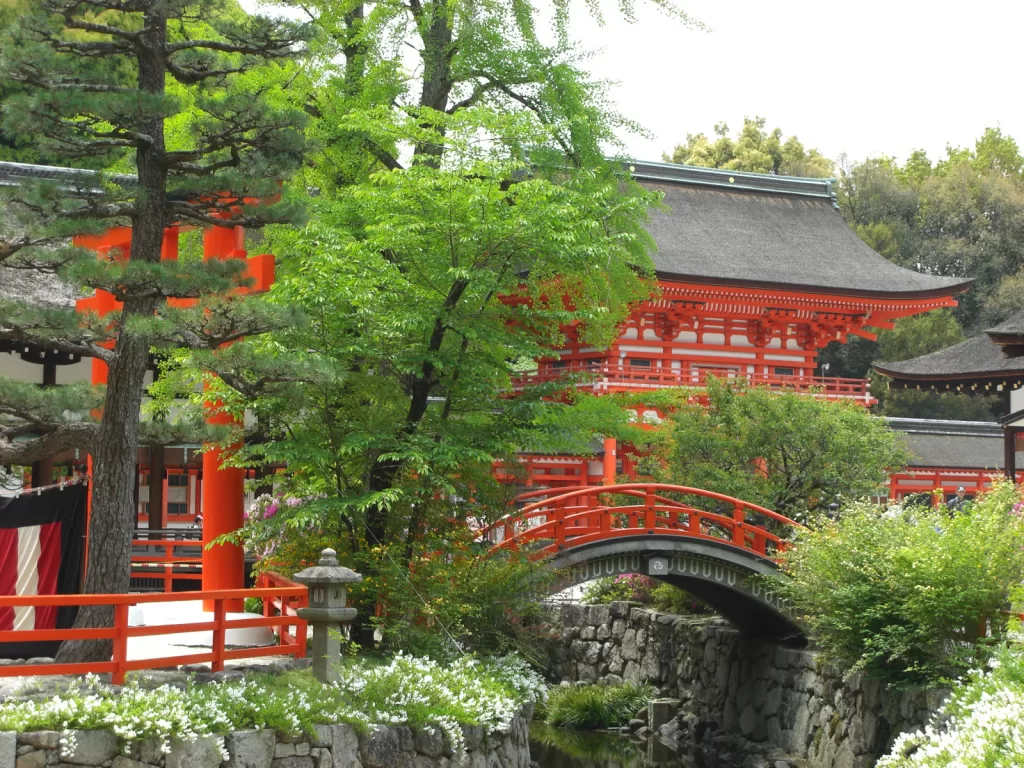Yabusame Shinji: A Spectacular Display of Japanese Mounted Archery

Shimogamo Shrine: A Historic Setting for Yabusame Ritual
Every year on May 3rd, the historic Shimogamo Shrine in Kyoto, Japan, adorned by the verdant expanse of the Tadasu no Mori forest, becomes the centerpiece for a grandiose spectacle – Yabusame Shinji. Renowned as a traditional demonstration and Shinto ritual of mounted Japanese archery, Yabusame Shinji marries kinesis and precision with prehistoric ceremonial traditions. It’s one of the most awaited Kyoto events in May.
Named after ‘yabusame’, meaning Japanese horseback archery, the well-attended event traces its roots back to the Kamakura period in the 12th century. Initiated by Minamoto no Yoritomo, founder of the Kamakura shogunate, yabusame served as an energising and challenging training regimen for samurais.
Aoi Matsuri: Tying in Ancient Traditions with Yabsuame
The Yabusame Shinji is inseparable from its association with Aoi Matsuri (Hollyhock Festival). Known as among Kyoto’s biggest three festivals, Aoi Matsuri is held every May 15. The month-long celebrations mark various rituals and ceremonial preparations instilling an infectious excitement throughout Kyoto.
Shimogamo Shrine along with its counterpart Kamigamo Shrine are focal points during Aoi Matsuri. These two world heritage sites exude vibrance and sacredness through their multitude festivities including purification rituals and high-paced horse races.
Yabusame Shinji holds a prevalent place in these ceremonies. Orchestrated within the hushed whispers of Tadasu no Mori forest at Shimogamo Shrine, it begins about halfway through the festival at exactly 13:00 on May 3rd. The primary purpose? To invoke blessings for safety during future processions and cleansing of the parade route.
Introducing Heroes Behind The Scenic Action
Five participants specially selected from descendants of Ogasawara clan – famed originators of notable Yabusame tournaments dating back to 1187 – grace this dynamic ritual on horseback. These modern-day warriors possess varied backgrounds stretching from chemical researchers to actors featuring in renowned films such as “The Last Samurai.”
The grand ceremony commences post introductions where each rider prepares to demonstrate their years of rigorous training in quick succession. They align themselves onto a 255-meter long track where three targets await their arrows along the left side.
A Marvelous Display of Skill and Tradition
Once set in motion, horses gallop at high speed down the tracks while riders focus intensely on hitting targets fixed at a strategic height equivalent to just below an enemy’s helmet visor. This setup is derived from ancient times where fully armored samurai’s eyes were their main vulnerability during combats.
As this picturesque scene unfolds within Shimogamo Shrine’s awe–inspiring surroundings, onlookers often echo cheers each time an archer successfully hits a target.

Navigating Challenges Faced by Today’s Yabusame Archers
Though steeped in tradition and aesthetics, yabusame requires acute proficiency which is evident through how riders must be faster than their predecessors – near twice as fast! When conceptualised originally, horses used were small breeds managing course completion almost up to half a minute. However, longer-legged varieties currently in use reduce that time significantly owing to their enhanced speed capabilities.
Reserving free views spots may require arriving extremely early due to crowds gathering up even 40 minutes before commencement leaving little room for latecomers. Additionally obtaining front row seats involve paying up but they sell out quickly too!
For attendees interested in capturing fleeting moments throughout performances, it poses quite a challenge owing to low light resulting from dense foliage around Shimogamo Shrine coupled with strict restrictions against using flash to prevent impairing horses’ concentration.
Sublime Costumes Add Flair and Authenticity
Symbolism doesn’t end only with action witnessed; equally appealing are traditional costumes donned by participating archers that seem borrowed straight from history books teleporting viewers back in time. Each outfit enhances overall impression of mastery demonstrated all while saluting Japan’s tactical warfare legacy where horseback shooting was cardinal.
Ensuring Safety During Aoi Matsuri
In its essence yabusame serves twofold purpose — apart from representing unique martial prowess amid galloping equines displaying thrilling techniques with shutter-speed precision echoing cries “in-yo”, known as darkness and light or yin-yang philosophy — it functions towards ensuring Aoi Matsuri takes place smoothly without obstacles year after year.
Whether you’re keen equestrian event enthusiast or someone seeking rich immersive experiences courtesy nuances distinctive only to Japanese culture, attending yearly displays at Shimogamo Shrine will certainly leave you mesmerised!
Target practice throughout Tadasu no Mori foliage both excites spectators by presenting aesthetic prowess and fulfilling vital ritualistic purpose based on popular beliefs – if arrows hit intended aims then Kyoto can expect abundant crop harvest that year seeing wishes come true.
Looking for an exciting cultural experience in Kyoto? Take advantage of the annual Fujinomori Matsuri festival held between May 1 and 5 in the heart of Fushimi Ward.